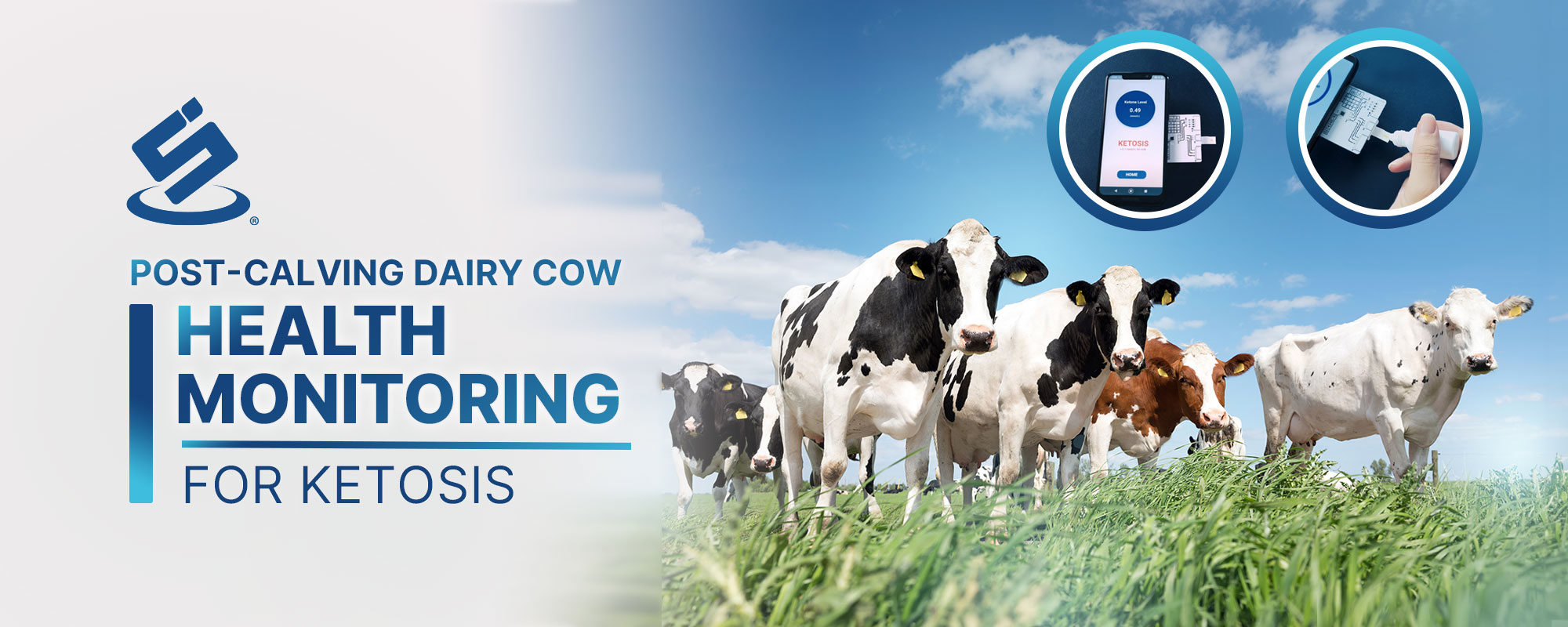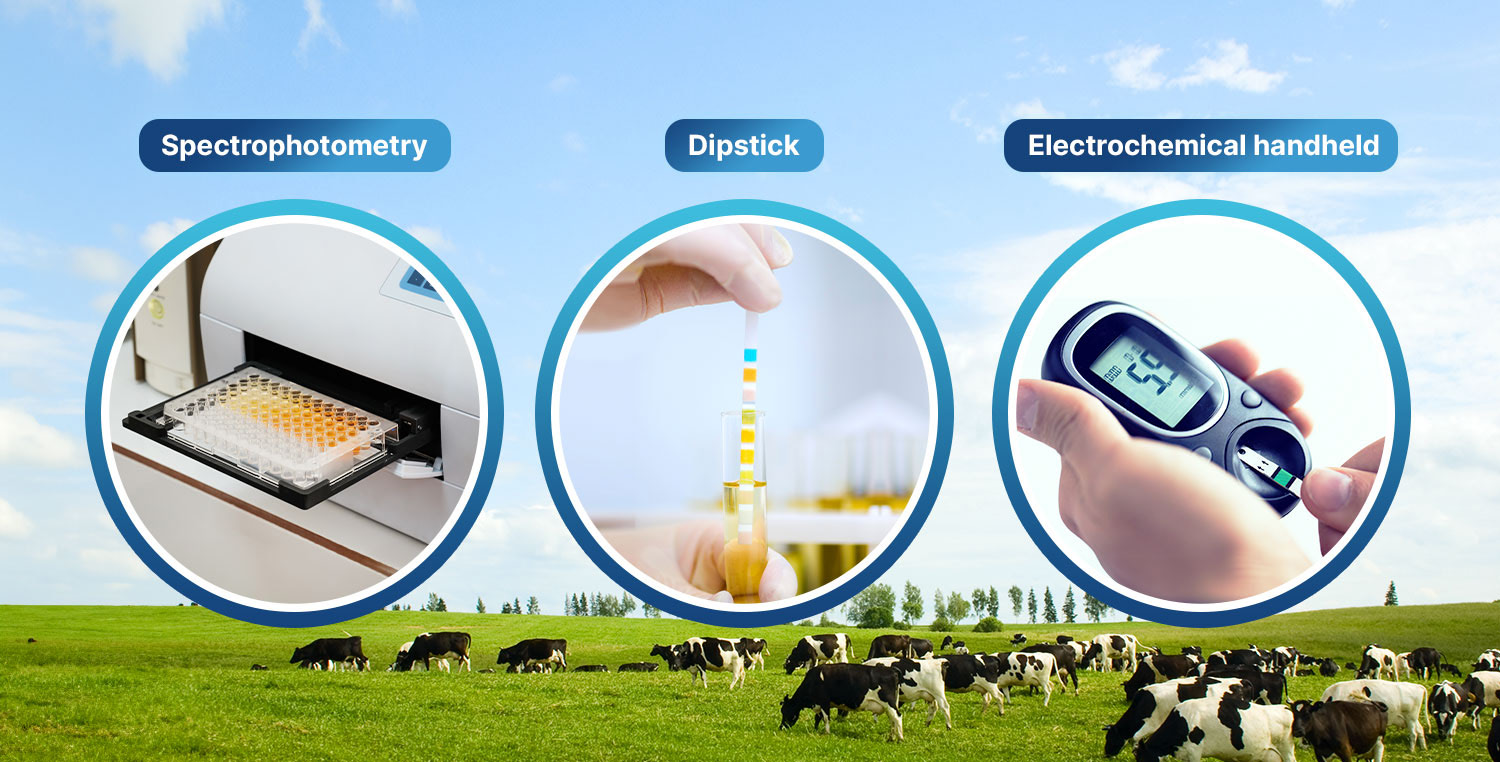White Papers
Post-Calving Dairy Cow Health Monitoring for Ketosis

Understanding ketone bodies is crucial in the context of dairy farming. Ketone is a group of organic compounds consisting of β-hydroxybutyric acid (βHBA), acetoacetic acid (ACAC), and acetone (AC). These compounds are the product of fat metabolites during the oxidation of free fatty acid in the liver, a process known as ketogenesis. This occurs when the body uses fat as fuel for energy instead of glucose due to an imbalance between the energy taken into the body as feed and the energy lost when producing milk [1].
This imbalance triggers the liver to rapidly metabolize fatty acids into ketone bodies that circulate in the bloodstream, with the excess excreted through urine and milk. The elevated level of ketone bodies in cows can cause a disease called “ketosis.” This disease typically occurs in cows during early lactation or the first six to eight weeks. The negative impacts of ketosis may consist of reduced milk yield, impaired reproductive performance (e.g. infertility), a greater culling rate, and risk of other periparturient diseases, including displaced abomasum, lameness, mastitis, metritis, and retained placenta [2]. A concentration of βHBA above 1.2 mmol/L in blood, 0.1 mmol/L in milk and 1.5 mmol/L in urine is considered subclinical ketosis, while a level above approximately 3.0 mmol/L in the blood indicates used for clinical ketosis. It is also important to note that a single case of ketosis can cost around Canadian (CAD) CA$50 to CA$100 [3].
Another study reported that clinical and subclinical ketosis (SCK) average costs were €3,613 for default and €7,371 per herd per year [4] for high-risk farms, respectively. Therefore, it is more cost-effective and beneficial to the overall health and productivity of your dairy herd to prevent ketosis rather than treat it once it occurs.

There are various methods for diagnosing ketosis in dairy cows, each with its own advantages and limitations. The gold standard test is an enzymatic laboratory test based on spectrophotometry. While these methods are accurate, they can be inconvenient and costly, requiring specialized equipment and trained personnel [5]. Diagnosis methods that can be conducted on-farm are preferred. Dipstick tests that measure acetoacetate and acetone concentrations in urine and milk are 2 reasonably accurate when interpreted within 5-10 seconds.
However, delayed interpretation can lead to a higher rate of false-positive reactions [5]. To ensure precise and accurate results, allowing enough time for the color to develop is crucial. Handheld instruments have been designed to monitor ketone bodies in cows to overcome this issue. βHBA concentration is measured in blood using electrochemical detection with highly accurate on-farm testing [6]. The instrument uses a biosensor that detects the chemical changes when βHBA reacts with the reagents in the sensor to calculate its concentration. This instrument uses a three-electrode system that measures the electrical current generated by the reaction of βHBA. The current is proportional to the concentration of βHBA in the sample, allowing for accurate and precise measurements.

Fig 1: From left to right, spectrophotometry, dipstick, and electrochemical handheld device.
Ketone Measurement with
SIC4341 Sensor Interface Chip:
Ketone measurement was conducted by using the SIC4341 sensor interface chip. For highly sensitive and specific ketone measurement, the enzymatic-based electrode is employed for β-hydroxybutyrate (β-HB) determination in our test. To evaluate the ketone levels, a commercial ketone sensor strip and SIC4341 development kit was used, which allows electrochemically performing and collecting the data via smartphone.
SIC4341 NFC Potentiostat Sensor Inter face AFE was designed to induce electrochemical reaction by applying voltage to electrodes, then, measures electrical signal (current) generated from redox reaction and convert into digital data. SIC4341 chip integrates digital-to-analog converters (DACs) and analog-to-digital converter (ADC) with Potentiostat sensor interface circuit. These components are incorporated with NFC communication to deliver miniaturize solution enabling low-cost digitalized test kit for consumer level.
Read More on PDF White Paper



